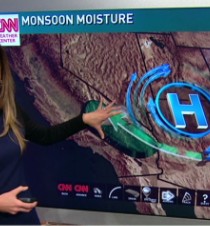

Some fires may have occurred under Santa Ana conditions - whether started by Native Americans, or by lighting that struck earlier, and smoldered until SAW conditions arose. These results suggest that the fire regime prior to EuroAmerican settlement may have been significantly different from that which has prevailed for the past century or more. The lightning that did occur was sparse: an average of 10.6 strikes per day on those SAW days that did experience it, compared with an average of 398.8 strikes/day on the non-SAW days that experienced lightning. This contrasts with non-SAW days, 20% of which experienced at least some lightning within the five county region. Only 22 of those (3.2%) experienced any lightning at all. In our 25-year study period, there were 694 SAW days. Our results indicate that lightning rarely coincides with Santa Ana conditions. We counted all strikes recorded in Los Angeles, San Bernardino, Riverside, Orange and San Diego counties during the period 1986-2010. in 2013 to determine how frequently lightning struck on SAW days. We use daily lightning counts downloaded from the NOAA Severe Weather Data Inventory (in turn derived from the Vaisala National Lightning Detection Network) and the compilation of SAW days published by Abatzoglou et al. We address this question by examining the extent to which lightning actually occurs during SAW conditions.

Downslope foehn winds seem unlikely to coincide with the convection that favors lightning, raising the question of how frequently natural ignition would be available when Santa Ana winds are blowing. But absent human influence, the only likely natural ignition source is lightning. In recent decades, the majority of wildfires in the region, whether during Santa Ana wind (SAW) conditions or not, have been caused by humans. In Southern California, "Santa Ana" foehn winds are thought to be responsible for the most extreme fire weather conditions, and have contributed to many of the largest wildfires on record.


 0 kommentar(er)
0 kommentar(er)
